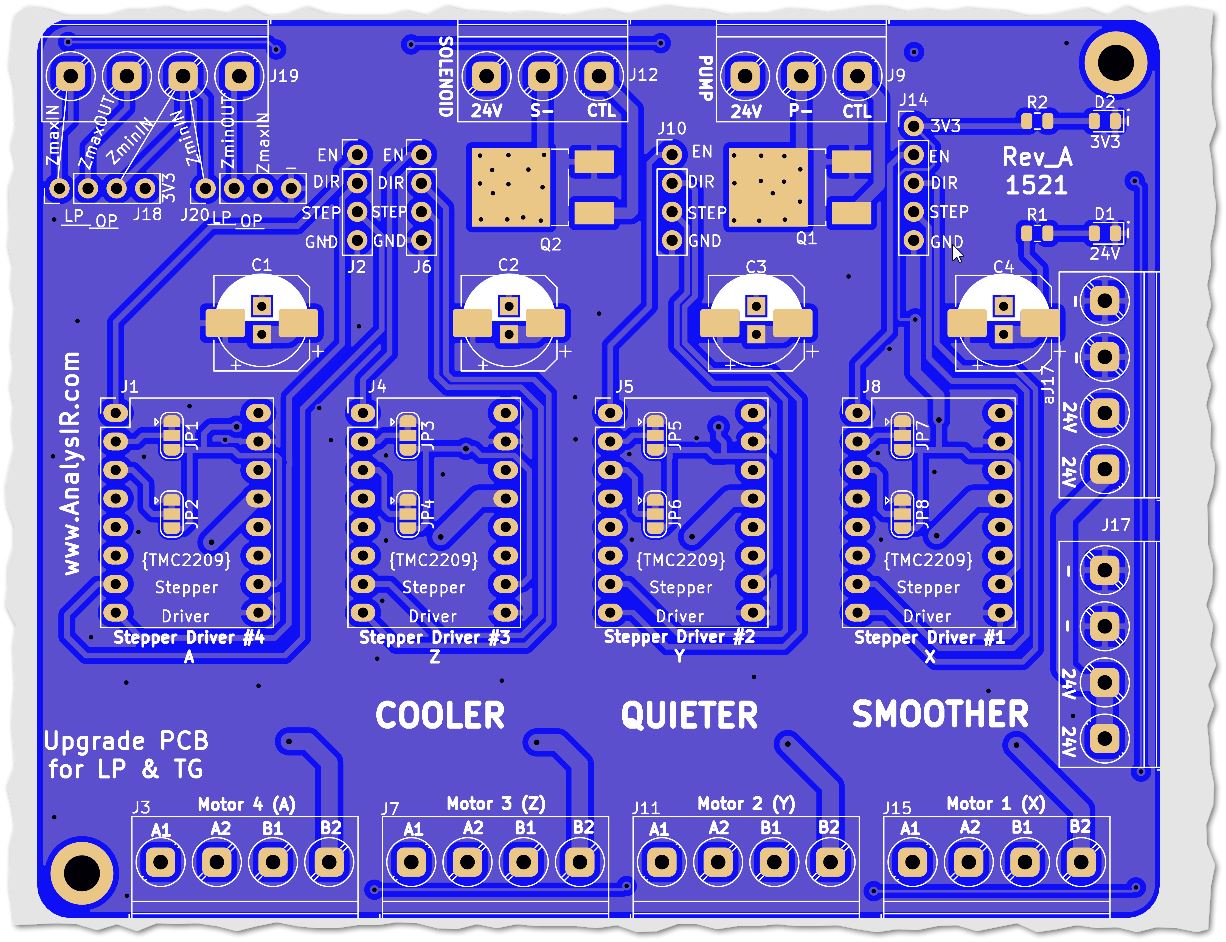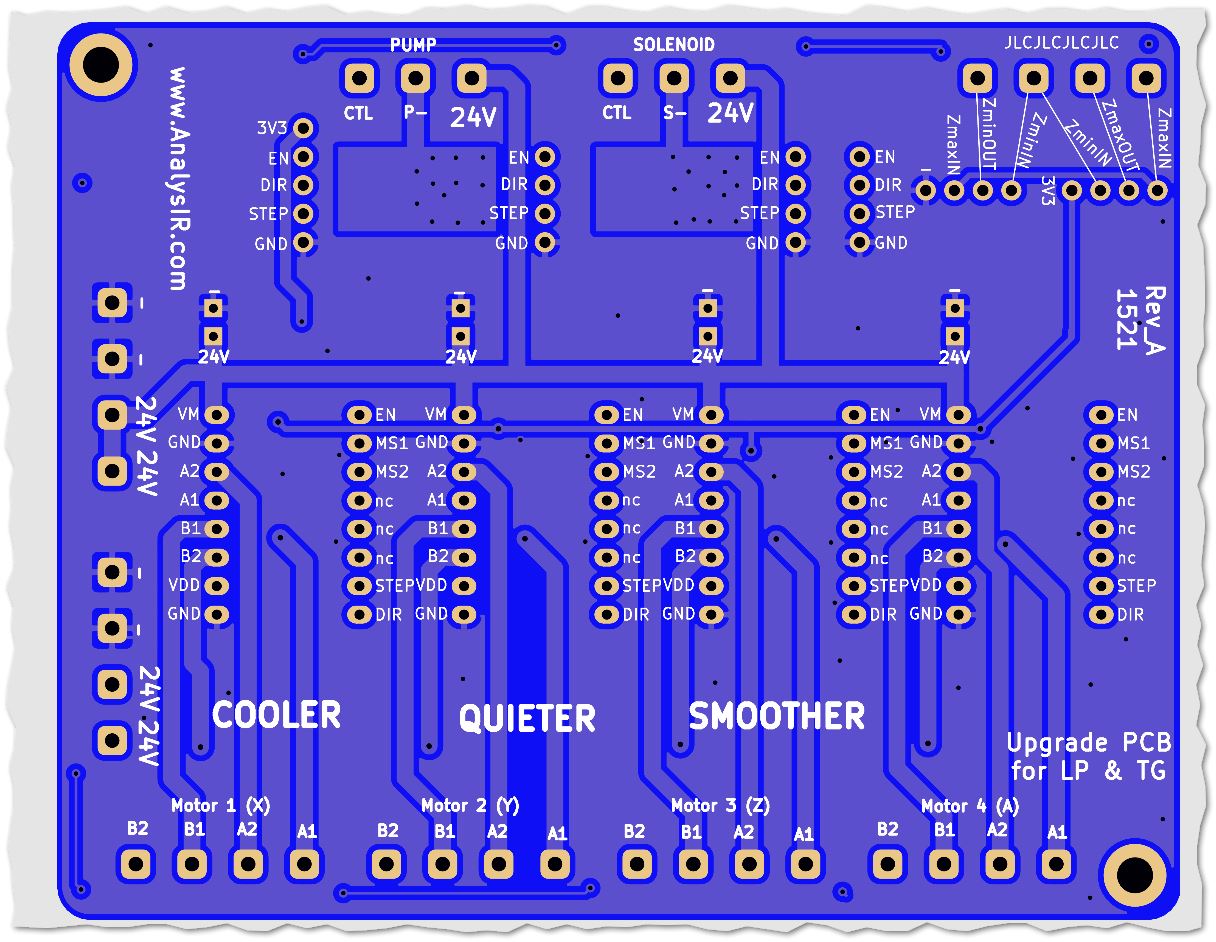TMC2209 TinyG upgrade assembly instructions
Here you can find the instruction for assembling your TMC2209 TinyG upgrade for LitePlacer, OpenPNP and other TinyG systems
The instructions assume you are installing headers for all 4 motors, which is recommended. However, if you only want to upgrade 2 or 3 stepper drivers, we suggest you install all the headers & connectors and only populate those positions you require.
Where to buy this upgrade?
You can purchase this PCB with optional components in our Tindie Store (Subject to availability)
Prerequisites
- Soldering - You must possess the training, skills and equipment required for soldering.
- Components - If you have not purchased the components, then you should source your own based on the BoM below.
- TinyG V8 controller Board - obviously you will need a TinyG to complete the upgrade.
- Your own TMC2209s from BigTreeTech v1.2
- A DMM with continuity functionality would help to check connections
- We spent several hours over a weekend completing this upgrade for LitePlacer.
Bill of Materials
- 1 x PCB (100x80mm)
- 7 x 4P 5.0mm pitch Screw terminals
- 2 x 3P 5.0mmm pitch Screw Terminals
- 2 x Jumpers 2.54mm pitch
- 6 x Male 2.54mm pitch Headers (4 extra long)
- 12 x 2.54mm pitch Female Headers
- 2 x 0805 red LEDs (see Note 1 below)
- 2 x 0805 resistors (for LEDs) 4K7 & 56K (see Note 1 below)
- 4 x TH capacitors (KEMET, 100uF 35V 105degC)
- 2 x STD30NF06LT4 (STMicroelectronics N-Channel MOSFET) (see Note 1 below)
You are free to use equivalents where appropriate. (e.g. soldering wires directly to the PCB instead of using the terminals, or SMD caps instead of the TH ones above)
(Note 1: When components are ordered only the SMD parts above are pre-soldered. You will have to solder all of the Through-hole parts)
Steps
- Take a photo of your existing wiring and label your wires going into the TinyG
- Remove the TinyG from your system, so you can work on it.
- At this point turn the POTs on the TinyG stepper drivers you will be upgrading to the lowest setting (refer to TinyG or LP docs). DO NOT FORGET THIS STEP!
- Note: all components are soldered to the top of the PCB (except the 4 long male headers)
- Solder the 4 female headers to the TinyG PCB (3x4P + 1x5P) and put the TinyG aside for now.
- Solder the 2 Mosfets (Pre-installed if components ordered) [Q1, Q2]
- Solder the 2 resistors (Pre-installed if components ordered) [R2 4K7, R1 56K]
- Solder the 2 LEDs (Pre-installed if components ordered) (0805 Red LED) [D1, D2]
- Solder the 7 Screw terminal Blocks (7x4P) [J19, J17a, J17, J15, J11, J7, J3]
- Solder the 2 Screw terminal Blocks (2x3P) [J12, J9]
- Solder the 2 short male headers (2x4P) [J18, J20]
- Solder the 8 female headers to accept the upgraded stepper drivers. (8x8P) [J1x2, J4x2, J5x2, J8x2]
- Solder the 4 Capacitors provided [C1, C2, C3, C4). Note we provide TH caps, but there is also a footprint for SMD caps. Make 100% certain that you identify the GND pad before soldering.
- Solder the 4 long male headers to the underside of the PCB. (3x4P + 1x5P) [J2, J6, J10 + J14]]
- Now insert the PCB into the TinyG board with care, to ensure a good fit. The PCB must be higher than any component on the TinyG.
- Insert the jumpers into J18 & J20. The position for LitePlacer and OpenPNP are marked on the PCB. Make sure not to jumper the 3V3 or GND pins. Make sure you are happy with the connections for Z-max & Z-min by checking the connections on J19 with your DMM.
- Before proceeding check all solder joints are good.
Gotchas
- Make sure all of the long headers are actually inserted into the female headers on the TinyG before testing or powering on. I made that mistake initially and was wondering why the Y axis was stuttering. :)
- Ensure you have made a record of and taken good photos of your TinyG wiring before you take it apart, so that you can easily wire up the new PCB.
Wiring
- The general approach is to mirror what you have already in your existing installation. It is assumed that you have a standard wiring install. (If not adjust as appropriate or contact us directly for support). Make sure to use wires with the same or better AWG & if you are drawing additional current that your power supply can handle it.
- Motors J15/11/7/3 - The positions are the same as for the TinyG, so simply moving the 4 wires for each motor to the new PCB will suffice.
- Z-Axis J19 - Connect the Zmax from the switch to the ZmaxIN, Zmin from the switch to the ZminIN. Connect the ZmaxOUT to the Zmax on the TinyG & the ZminOUT to the Zmin on the TinyG. Insert the 2 jumpers into position depending on LitePlacer vs OpenPNP configuration. The positions are marked on the PCB silkscreen.
- Jumpers - Make sure you have inserted the 2 jumpers into the correct position for LitePlacer or OpenPNP.
- Solenoid J12 - Connect the 24V pin to the Solenoid V+ and the S- to the Solenoid V- pins. The CTL should be connected to the control pin for the solenoid coming from the TinyG.
- Pump J9 - Connect the 24V pin to the Pump V+ and the S- to the Pump V- pins. The CTL should be connected to the control pin for the pump coming from the TinyG.
- Power - Move your main 24V supply wire from the TinyG to J17 and then add a connection from the 2nd 24V position back to the original 24V on the TinyG. Move your main GND supply wire from the TinyG to J17 and then add a connection from the 2nd GND position back to the original 24V on the TinyG. There is also a spare connector for 24V/GND on J17a with 2 positions each - available for you own use.
- Spare 3V3/GND pins - If you are using these connections for any purpose, wire them up now. If not using them, we suggest applying some electrical tape (or similar) so that you don't accidentally connect the jumper.
- Before connecting any of the stepper drivers, power the system on and confirm the 2 LEDs are lighting. If not disconnect power immediately and troubleshoot.
- Before applying power test the correct operation of the Zmax/Zmin connections with your DMM.
- Before inserting any of the stepper drivers test the correct operation of the Solenoid and the pump using LitePlacer/OpenPNP
- Steppers - Insert the upgraded steppers one at a time (with heat-sink) and test them out individually by jogging using LitePlacer or OpenPNP. Make sure the power is off each time before inserting the new drivers. Do not Home the machine until you have tested each motor individually.
Differences for OpenPNP
- The only difference is the position of the jumpers on J18 & J20.
Differences for 'Other TinyG Systems'
- The Zmax/Zmin features may not be required, as they apply for LitePlacer/OpenPNP only. However, feel free to use them for other purposes.
- The Solenoid & Pump switched may not be required. However, feel free to use them for other purposes.
- Motors - you may not need to upgrade all 4 motors.
Other sources of information
- The initial thread on the LitePlacer forum is available here. This has lots of relevant information from carbon-rod along with a YouTube Video. Note: the LitePlacer performs much quieter than can be heard in the video, after the upgrade.
- LitePlacer website
- LitePlacer Forum
- TinyG shop, website, wiki & forum
- TMC2209 Data Sheet & Documentation
- BigTreeTech product page (Stepper drivers are available cheaper via AliExpress)
- Our Tindie Store

